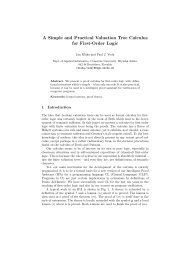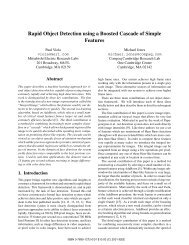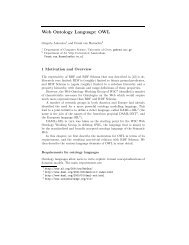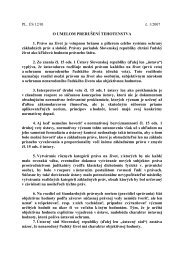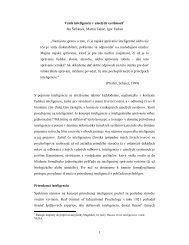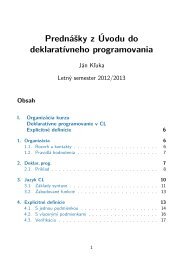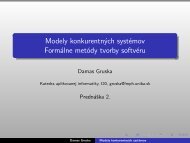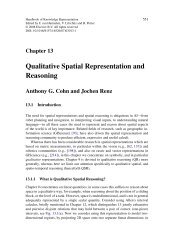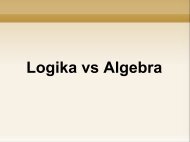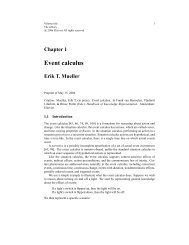A Proof Calculus with Case Analysis as its Only Rule
A Proof Calculus with Case Analysis as its Only Rule
A Proof Calculus with Case Analysis as its Only Rule
You also want an ePaper? Increase the reach of your titles
YUMPU automatically turns print PDFs into web optimized ePapers that Google loves.
A <strong>Proof</strong> <strong>Calculus</strong> <strong>with</strong> <strong>C<strong>as</strong>e</strong> <strong>Analysis</strong> <strong>as</strong> <strong>its</strong> <strong>Only</strong> <strong>Rule</strong> 11If all D i are different, we define the sequence {T i } ∞ i=0 byT 0 := {Π | A h<strong>as</strong> a hole at Π ′ and Π ′ extends Π}T i+1 := {Π | D i h<strong>as</strong> a hole at Π} ∪ T i ,and let T := ⋃ ∞i=0 T i. The set T is infinite and such that if Π ′ ∈ T and Π ′ extendsΠ, then Π ∈ T . This makes T a (set-theoretical) tree. It is finitely branchingbecause every Π ∈ T h<strong>as</strong> at most two immediate successors (extensions)in T . By König’s lemma, T h<strong>as</strong> an infinite branch Φ 0 ⊆ Φ 1 ⊆ Φ 2 ⊆ · · · ⊆ T .From the construction of T , all Φ i are syntactically consistent (<strong>with</strong> T and He).We set H := ⋃ ∞i=0 Φ i <strong>with</strong> the intention of showing that H is a maximal simplyconsistent Hintikka set s.t. T ⊆ H. By Lemma 5.3, there will be then a structureM H. Since Φ j = Π k for some j and k, we will get M A from Lemma 3.6(ii).The retraction M ′ to L of M will contradict the <strong>as</strong>sumption T L A.We first show that H is maximal in L[C] by taking any B ∈ L[C]. It is some B iin the enumeration of L[C] and thus Φ j+1 = Φ j ⊕ 〈B〉 or Φ j+1 = Φ j ⊕ 〈¬B〉 forsome j ≥ i. Hence one of B, ¬B is in H.We will need two auxiliary properties of H:No Π ⊆ H is a path to a hole in a sent. (1)–(5) of Par. 4.2 or in an A ′ ∈ H. (†)For every sentence B ∈ L[C] there is a path Π through B s.t. Π ⊆ H.(†) Assume Π ⊆ H. If Π is a path to a hole in a sentence (1)–(5), thenΠ ⊆ Φ j for some j, and Φ j is syntactically inconsistent. If Π is a path to a holein A ′ , then A ′ , Π ⊆ Φ j for some j, and Φ j is syntactically inconsistent.(∗) We proceed by induction on B. If B is ⊤ or ⊥, then set Π := 〈〉 ⊆ H.If B is prime, then by maximality B or ¬B is in H, and so set Π := 〈B〉 ⊆ Hin the first c<strong>as</strong>e, and Π := 〈¬B〉 ⊆ H in the second. If B ≡C , then C orD E¬C is in H by maximality. In the first c<strong>as</strong>e, set Π := 〈C | Π ′ 〉 where Π ′ ⊆ H isobtained from IH <strong>as</strong> a path through D. The second c<strong>as</strong>e is similar.We will now show that H is simply consistent. Assume that both B and ¬Bare in H. By (∗), there is a path Π through B s.t. Π ⊆ H. Since the same Πis also a path through ¬B, Π leads to a hole of exactly one of B or ¬B. Thiscontradicts (†) where A ′ is B or ¬B.We will now show that T is a subset of H. Take any B ∈ T . 〈¬B〉 ⊆ Hviolates (†)(5). Hence B ∈ H by the maximality of H.It remains to show that H is a Hintikka set:(i) Since 〈〉 ⊆ H, and it is a path to a hole of ⊥, ⊥ ∈ H would violate (†) <strong>with</strong>A ′ ≡ ⊥. Hence ⊤ ∈ H by the maximality of H. We cannot have 〈t ≠ t〉 ⊆ H by(†)(2). Hence (t = t) ∈ H by the maximality of H.(ii) If (s = t), P [x/s] ∈ H then, since 〈s = t, P [x/s], ¬P [x/t]〉 ⊆ H wouldviolate (†)(3), we must have P [x/t] ∈ H by the maximality of H.(iii) If A ′ :≡B ∈ H, then there is a path Π ⊆ H through C D A′ by (∗).By (†), Π cannot lead to a hole of A ′ . Exactly one of B, ¬B is in H. If theformer, then Π = 〈B | Π ′ 〉 <strong>with</strong> Π ′ a path through C. Π ′ cannot be a path to ahole of C because then A ′ would have a hole at Π. Hence Π ′ is a path to a hole(∗)



